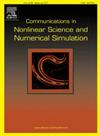低至高维双稳系统中的逆非周期共振:对逻辑电路中随机共振研究的补充
IF 3.4
2区 数学
Q1 MATHEMATICS, APPLIED
Communications in Nonlinear Science and Numerical Simulation
Pub Date : 2025-05-02
DOI:10.1016/j.cnsns.2025.108930
引用次数: 0
摘要
随着电路尺寸的不断缩小,噪声已成为实现最佳性能的关键挑战。逻辑电路中的随机共振提供了一种建设性地治理噪声的创新方法;然而,目前的实现仅限于基本的逻辑功能,如OR、AND、NOR和NAND,限制了更广泛的应用。本文引入一个三维耦合模型来研究非线性系统在噪声作用下产生的反直觉现象。与一维Langevin方程和二维Duffing方程相比,三维耦合模型具有更多可调参数和耦合作用,增强了系统的动力学行为。研究表明,增大噪声强度会触发反向非周期共振,导致信号相位反转和幅度放大。这种现象归因于布朗粒子在双稳势阱中的运动。此外,反向非周期谐振通过引入噪声驱动的相位反转,解决了传统随机谐振系统中缺乏逻辑否定的问题,为传统逆变器提供了一种新的替代方案。本文章由计算机程序翻译,如有差异,请以英文原文为准。
Reverse aperiodic resonance in low- to high-dimensional bistable systems: A complement to stochastic resonance studies in logic circuits
As circuits continue to shrink in size, noise has emerged as a critical challenge in achieving optimal performance. Stochastic resonance in logic circuits offers an innovative approach to harness noise constructively; however, current implementations are limited to basic logical functions such as OR, AND, NOR, and NAND, restricting broader applications. This paper introduces a three-dimensional (3D) coupling model to investigate the counterintuitive phenomena that arise in nonlinear systems under noise. Compared to the one-dimensional Langevin equation and the two-dimensional Duffing equation, the 3D coupling model features more adjustable parameters and coupling interactions, enhancing the system's dynamic behavior. The study demonstrates that increasing noise intensity triggers reverse aperiodic resonance, leading to signal phase reversal and amplitude amplification. This phenomenon is attributed to the motion of Brownian particles in a bistable potential well. Additionally, reverse aperiodic resonance addresses the lack of logical negation in traditional stochastic resonance systems by introducing noise-driven phase reversal, providing a novel alternative to conventional inverters.
求助全文
通过发布文献求助,成功后即可免费获取论文全文。
去求助
来源期刊

Communications in Nonlinear Science and Numerical Simulation
MATHEMATICS, APPLIED-MATHEMATICS, INTERDISCIPLINARY APPLICATIONS
CiteScore
6.80
自引率
7.70%
发文量
378
审稿时长
78 days
期刊介绍:
The journal publishes original research findings on experimental observation, mathematical modeling, theoretical analysis and numerical simulation, for more accurate description, better prediction or novel application, of nonlinear phenomena in science and engineering. It offers a venue for researchers to make rapid exchange of ideas and techniques in nonlinear science and complexity.
The submission of manuscripts with cross-disciplinary approaches in nonlinear science and complexity is particularly encouraged.
Topics of interest:
Nonlinear differential or delay equations, Lie group analysis and asymptotic methods, Discontinuous systems, Fractals, Fractional calculus and dynamics, Nonlinear effects in quantum mechanics, Nonlinear stochastic processes, Experimental nonlinear science, Time-series and signal analysis, Computational methods and simulations in nonlinear science and engineering, Control of dynamical systems, Synchronization, Lyapunov analysis, High-dimensional chaos and turbulence, Chaos in Hamiltonian systems, Integrable systems and solitons, Collective behavior in many-body systems, Biological physics and networks, Nonlinear mechanical systems, Complex systems and complexity.
No length limitation for contributions is set, but only concisely written manuscripts are published. Brief papers are published on the basis of Rapid Communications. Discussions of previously published papers are welcome.
 求助内容:
求助内容: 应助结果提醒方式:
应助结果提醒方式:


